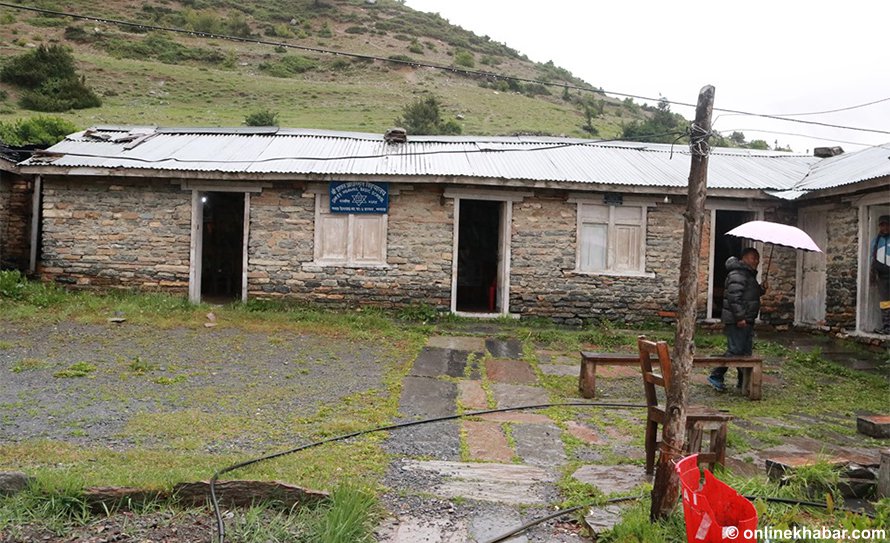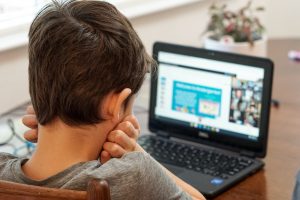 After the school of her two sons was closed due to the coronavirus outbreak in March, Shanti Nepal went back to her village in Kavre with her sons. Now, she is undecided whether she should come back to Kathmandu, as her sons’ school has decided to resume classes through online platforms.
After the school of her two sons was closed due to the coronavirus outbreak in March, Shanti Nepal went back to her village in Kavre with her sons. Now, she is undecided whether she should come back to Kathmandu, as her sons’ school has decided to resume classes through online platforms.
Other parents in her neighbourhood were also notified by their children’s schools about online classes and some of them have returned to Kathmandu, hiding in vegetable trucks, disobeying the lockdown, and risking the Covid-19 contagion.
A man who travelled back to Kathmandu with his family members hiding in such a truck shares, “I am worried that I may not be able to help my daughter despite coming back to Kathmandu as I lack knowledge and skills required to facilitate the online classes even though we have access to a computer and the internet at home.”
While those having computers and the internet at home are also unprepared to kickstart the online classes, one can easily imagine the current status of the parents who have neither a computer nor an internet connection. In the light of insufficient preparation of educational stakeholders and a huge number of parents and students who do not possess resources required for digital education, the introduction of online classes may well intensify the digital divide. Educational inequalities are also exacerbated between well-resourced and under-resourced schools that have pre-existed in Nepal’s education systems. This further creates inequalities in the Nepali society.
 Like other disasters and emergencies, the Covid-19 outbreak has also differential impacts on people and they are affected disproportionately based on various intersecting factors such as gender, geography, and socioeconomic status.
Like other disasters and emergencies, the Covid-19 outbreak has also differential impacts on people and they are affected disproportionately based on various intersecting factors such as gender, geography, and socioeconomic status.
Many countries have imposed lockdowns, closing schools and universities for months. According to a UNESCO estimate, 1.7 billion students, or more than 90% of the world’s learners are forced to stay at home due to the Covid-19 lockdowns across the globe. In most of the places, online classes have been embraced as the best solution.
The government of Nepal has also enforced the nationwide lockdown. Schools and universities are closed and major examinations are halted including the SEE and grade 11 and 12 finals. Over 35,000 schools are currently closed and over eight million students are staying at home. Meanwhile, some private schools have opted to go digital and operate online classes. But, concerns of thousands of the parents like Shanti Nepal and the man who travelled to Kathmandu hiding in a vegetable truck have not been addressed.
The digital divide refers to the gap between people and regions that have access to modern information and communications technology, and those that do not have or only have restricted access. ‘Technology’ can include telephones, televisions, personal computers, and the internet. The Merriam-Webster dictionary defines a digital divide as “the economic, educational, and social inequalities between those who have computers and online access and those who do not”. The digital divide typically exists between those in cities and those in rural areas; between the educated and the uneducated; between socioeconomic groups; and, between the developed and developing nations globally. Even among the populations with some access to technology, the digital divide can be in existence in the form of lower-performance computers and devices and lower-speed or unreliable internet connections.
 According to the 2011 national census, only 7.28% of households own a computer and as little as 3.33% have a household internet connection in Nepal. The ownership of radio, television, and mobile phones stood at 50.82%, 36.45%, and 64.63% respectively. The Nepal Media Landscape Survey carried out by Sharecast Initiative Nepal in 2018 illustrates that the ownership of radio sets and mobile phones has increased to 59% and 98% respectively. Similarly, the survey shows that 72% of households in Nepal own a TV set and nearly 60% of people watch television every day. While the ownership of these household amenities has increased dramatically since 2011, the disparity in the distribution of these resources between urban and rural areas and across classes is still high.
According to the 2011 national census, only 7.28% of households own a computer and as little as 3.33% have a household internet connection in Nepal. The ownership of radio, television, and mobile phones stood at 50.82%, 36.45%, and 64.63% respectively. The Nepal Media Landscape Survey carried out by Sharecast Initiative Nepal in 2018 illustrates that the ownership of radio sets and mobile phones has increased to 59% and 98% respectively. Similarly, the survey shows that 72% of households in Nepal own a TV set and nearly 60% of people watch television every day. While the ownership of these household amenities has increased dramatically since 2011, the disparity in the distribution of these resources between urban and rural areas and across classes is still high.
The equipment and facilities the online classes require surely are not affordable for many people even in the normal condition in countries like ours where 24.8% of the population is living under the poverty line. Now, with the lockdown in effect, the purchasing power of many people in Nepal has been further reduced as many have lost their jobs due to the global pandemic and are finding it extremely difficult to provide for their families. Unavailability of the resources required for e-learning may take many children away from the education system. Such children are most likely to be engaged in activities that are harmful to their social, physical, and emotional development. Many of them might end as child labourers.
Similarly, online classes may have detrimental impacts on the existing educational inequalities, especially between the students of public and private schools. Out of 29,000 public schools in Nepal, only 13% are equipped with computer labs and internet facilities. This is the ratio of schools equipped with computers and the internet, not the students. Therefore, making online classes inclusive and accessible, particularly to poor families and those living in rural areas, is an uphill climb that the country’s education system needs to make.

The coronavirus crisis has provided an unprecedented opportunity to redefine the education system. But, this also calls for: 1) massive investments to increase access to computers, the internet and other equipment particularly among economically poor families; 2) carefully planned strategies in consultation with education experts and learning from the best practices around the globe; 3) well-coordinated context-specific efforts from education authorities and three tiers of government; 4) accessible and affordable services from telecommunication and internet service providers; 5) upgrading the technical know-how of teachers and incentivising creativity and innovation; and 6) effective use of radio, television, and telephones in distance learning. Apart from delivering lectures, assignments, and curricular contents, e-learning classrooms, and online platforms should be used more to help students to think critically, be creative, appreciate their surroundings and nature, learn life skills, provide psychosocial support and ensure mental wellbeing.
This time should be taken as an opportunity to decide the face of future learning. As confusion rules the education stakeholders now, a new modality of education may easily get through and become familiar in a short time. Therefore, education authorities should introduce a digital learning system that will make sure that the educational activities do not have to wait until the pandemic is over. In doing so, we need to ensure that the alternative modality of education will not amplify inequalities by putting under-resourced students at a greater disadvantage than those of wealthier families.






















